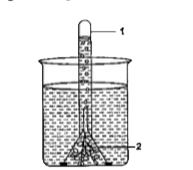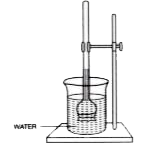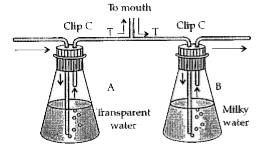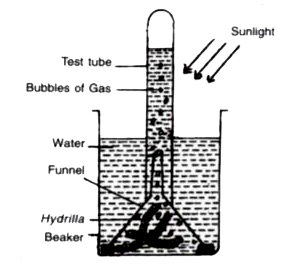In an experiment demonstrating the evolution of oxygen in Hydrilla , sodium bicarbonate is added to water in the experiment set-up . What would happen if all other conditions are favourable ?
Amount of oxygen evolved decreases as the availability of carbondioxide increases
Amount of oxygen evolved increases as carbondioxide in water is absorbed by sodium bicarbonate
Amount of oxygen evolved decreases as carbondioxide in water is absorbed by sodium bicarbonate
Amount of oxygen evolved increases as the availability of carbon dioxide increase
The correct Answer is:D
To solve the question regarding the effect of adding sodium bicarbonate to water in an experiment with Hydrilla, we can follow these steps:
1. Understand the Role of Hydrilla:
- Hydrilla is an aquatic plant that performs photosynthesis, using carbon dioxide (CO2), water (H2O), and light (usually from the sun) to produce glucose and oxygen (O2).
2. Identify the Function of Sodium Bicarbonate:
- Sodium bicarbonate (NaHCO3) is added to the water. In solution, it dissociates to release bicarbonate ions (HCO3-) which can react with water to form carbonic acid (H2CO3).
3. Carbonic Acid Decomposition:
- The carbonic acid can decompose into carbon dioxide (CO2) and water (H2O). This reaction increases the concentration of CO2 in the water.
4. Effect of Increased CO2 on Photosynthesis:
- CO2 is a crucial reactant in the photosynthesis process. An increase in CO2 availability enhances the rate of photosynthesis, assuming light and temperature conditions are optimal.
5. Oxygen Production:
- As the rate of photosynthesis increases due to higher CO2 levels, the amount of oxygen produced as a byproduct also increases.
6. Conclusion:
- Therefore, if all other conditions are favorable, adding sodium bicarbonate will lead to an increase in the amount of oxygen evolved by Hydrilla.
Final Answer:
The correct answer is: The amount of oxygen evolved increases as the availability of carbon dioxide increases. (Option 4)
---
- Hydrilla is an aquatic plant that performs photosynthesis, using carbon dioxide (CO2), water (H2O), and light (usually from the sun) to produce glucose and oxygen (O2).
- Sodium bicarbonate (NaHCO3) is added to the water. In solution, it dissociates to release bicarbonate ions (HCO3-) which can react with water to form carbonic acid (H2CO3).
- The carbonic acid can decompose into carbon dioxide (CO2) and water (H2O). This reaction increases the concentration of CO2 in the water.
- CO2 is a crucial reactant in the photosynthesis process. An increase in CO2 availability enhances the rate of photosynthesis, assuming light and temperature conditions are optimal.
- As the rate of photosynthesis increases due to higher CO2 levels, the amount of oxygen produced as a byproduct also increases.
- Therefore, if all other conditions are favorable, adding sodium bicarbonate will lead to an increase in the amount of oxygen evolved by Hydrilla.
The correct answer is: The amount of oxygen evolved increases as the availability of carbon dioxide increases. (Option 4)
Topper's Solved these Questions
- BOOK - AAKASH SERIESCHAPTER - PHOTOSYNTHESIS IN HIGHER PLANTS EXERCISE - Exercise - III27videos
PHOTOSYNTHESIS IN HIGHER PLANTS
- BOOK - AAKASH SERIESCHAPTER - PHOTOSYNTHESIS IN HIGHER PLANTS EXERCISE - Exercise - III27videos
PHOTOSYNTHESIS IN HIGHER PLANTS
- BOOK - AAKASH SERIESCHAPTER - ORGANISMS AND POPULATIONSEXERCISE - EXERCISE-III (PREVIOUS AIPMT/NEET QUESTIONS)35videos
ORGANISMS AND POPULATIONS
- BOOK - AAKASH SERIESCHAPTER - PLANT GROWTH AND DEVELOPMENT EXERCISE - EXERCISE -III (PREVIOUS AIPMT/NEET QUESTIONS)27videos
PLANT GROWTH AND DEVELOPMENT
Similar Questions
In an experiment on O2 evolution by photosynthesising Hydrilla plant, a pinch of sodium bicarbonate is added to water. The rate of photosynthesis or O2 evolution will
View SolutionWhat would happen, if all the oxygen present in the enviroment is converted to ozone ?
View SolutionThe following diagram demonstrates a physiological process taking place in green plants. The whole set up was placed in bright sunlight for several hours. Study the diagram and answer the questions that follow:

What would happen to the rate of bubbling of the gan if a pinch of sodiam bicarbonate is added to the water in the beaker? Explain your answerView SolutionThe diagram given below represents an experimental set-up to demonstrate a vital process. Study the same and then answer the questions that follow :

What would you observe in the experimental set-up after an hour or so ?View SolutionIt states that matter can neither be created nor destroyed.
This law was put forth by Antoine Lavoisier in 1789 . He performed rections for reaching to the above conclusion. This law formed the for several later developments in chemistry . Infact , this was the result of exact measurement of masses of reactants and products, and carefully planned experiments performed by Lavoisier
6.3 g of sodium bicarbonate is added to 15 g acetic acid solution .CO2 formed is allowed to escape. The weight of the solution left is 18 gram . What is the mass of CO2 formed.View SolutionStudy the experimental set-up given below and answer the following questions:

What is the aim of the experiment shown above ?View SolutionGiven below is an experimental set-up to demonstrate a particular process. Study the same and answer the questions that follow :

What would you observe in the experimental set up after an hour? Give a reason to support your answer.View SolutionA psychologist set up an experiment to study the tendency of a person to select the first item when presented with a series of items. In the experiment, 300people were presented with a set of five pictures arranged in random order. Each person was asked to choose the most appealing picture. Of the first 150participants,36 chose the first picture in the set. Among the remaining 150 participants, p people chose the first picture in the set. If more than 20% of all participants chose the first picture in the set, which of the following in equalities best describes the possible values of p ?
View SolutionAnswer the following:
(a) what are coherent sources of light ? Two slits in Young's double slit experiments are illuminated by two different sodium lamps emitting light of the same wavelength. Why is no interference pattern observed?
(b) Obtain the condition for getting dark and bright fringes in Young's experiment. Hence write the expression for the fringe width.
(c) If s is the size of the source and its distance from the plane of the two slits, what should be the criterion for the interference fringes to be seen?View SolutionThe figure below represents an experiment set-up to study a physiological process in plants

What would happen to the rate of bubbling of the as it a pinch of sodium bicarbonato is added to the water in the beaker ? Explain your answerView Solution

